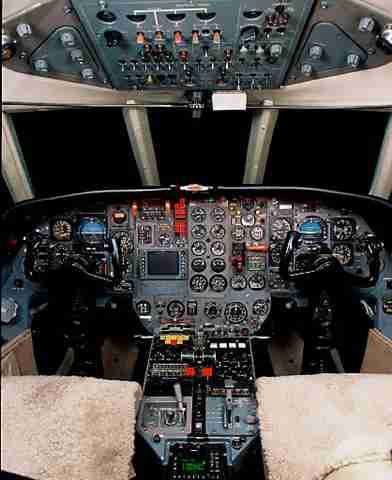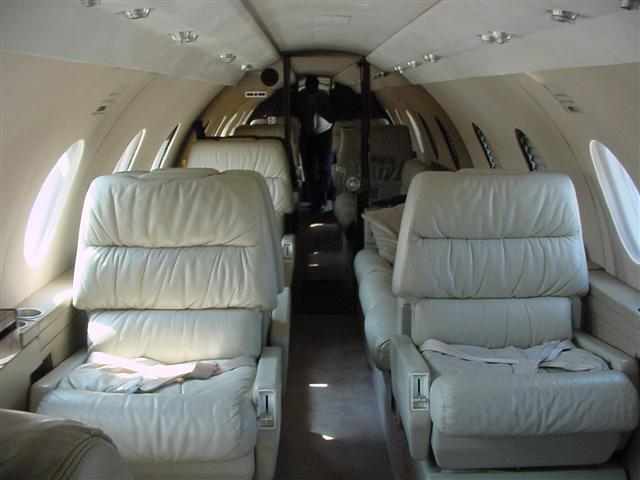


Aircraft Description
Background/History
In the late 1950’s Dassault began talks with Sud Aviation regarding joint development of a twin-turbojet business aircraft. The prototype of the Mystere 20 made its first flight in May 1963. It was powered by a pair of 3,300lb. Thrust Pratt & Whitney JTF12A-8 turbojets mounted on each side of the aft fuselage. It was subsequently re-engined with a pair of General Electric CF700 turbofans which became the standard power plant. The first production aircraft of the type flew in January 1965 and was marketed in the United States as the Fan Jet Falcon, and later as the Falcon 20. Several variants of the basic design were produced including the 20C with greater fuel capacity, the 20D with more powerful CF700-2Ds and the 20E with 4,500lb. thrust CF700-2D-2 turbofan engines. The inclusion of high-lift devices added to the wings to improve landing and takeoff performance and a further increase in fuel capacity mark the changes incorporated in the final variant, the Falcon 20F which was in production from 1971-1983 with a production run of 230 aircraft.
Power
The original Falcon 20 was powered by a pair of General Electric CF700-2C turbofans rated at 4,125lbs. of thrust each. Subsequent models utilized the 4,250lb. thrust CF700-2D (Falcon 20D), or the 4,500lb. thrust CF700-2D-2 (Falcon 20E and 20F). Inspection interval on the -2D2 engine is 5,000 hours.
Avionics
The avionics equipment packages installed in Falcon 20s varied depending on the time period in which the aircraft was built, 1971-1983, but all were fitted with the analog equipment and electromechanical instruments of the day. Most have since been upgraded to digital electronics, with a typical package consisting of dual Collins VHF 20 comms, VIR 30 navs, dual DME, dual transponders, Collins AP 105 autopilot and Sperry Primus 400 color weather radar.
Design Features
The Falcon 20F is a mid-size, medium-range business aircraft configured as a cantilever swept, low-wing monoplane with a cantilever cruciform tail section. The airframe is of aluminum monocoque construction and has a retractable tricycle landing gear with dual wheels on each unit. The two turbofan powerplants are rear-fuselage mounted. An airstair door is located on the forward port side of the fuselage.
Accomodations
The Falcon 20F is normally configured to seat eight to ten passengers in a double-club arrangement or a combination of club, divan and individual seating. The galley is located in the forward cabin and the lavatory Iis located in the aft cabin. Cabin height is 5.7ft, width is 6.2ft. and length is 24.0ft.
| General | Falcon 20F, DA-20F | |||
|---|---|---|---|---|
| Category | Jet < 20,000 lbs. | |||
| Years Aircraft Manufactured | 1971 – 1985 | |||
| Serial Number Range | 247 – 486 | |||
| Retail High Price | $995,000.00 / 780,776.50€ | |||
| Retail Low Price | $445,000.00 / 349,191.50€ | |||
| Characteristics | Falcon 20F, DA-20F | |||
| Seating | 2 + 9/10 | |||
| Wing Loading | 65.1 | |||
| Power Loading | 3.2 | |||
| Noise(EPNdB): Takeoff/Sideline/Approach | 90.0/103.0 | |||
| External Dimensions (ft) | Falcon 20F, DA-20F | |||
| External Length | 56.3 | |||
| External Height | 17.4 | |||
| External Span | 53.5 | |||
| Internal Dimensions (ft) | Falcon 20F, DA-20F | |||
| Internal Length (Overall/Net Height) | 24.0 | |||
| Internal Height | 5.7 | |||
| Internal Width (Max/Floor) | 6.2 | |||
| Baggage | Falcon 20F, DA-20F | |||
| External: Cu.Ft./Lb. | N/A | |||
| External: Cu.Ft./Lb. | N/A | |||
| Power | Falcon 20F, DA-20F | |||
| Engines | 2 GE CF7002D2 | |||
| Output (lbs ea.)/Flat Rating | 4,500 | |||
| Inspection Interval | 5,000t | |||
| Data based on latest manufactured year | ||||



